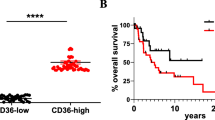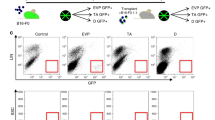Abstract
Vasculogenic mimicry was first described as the unique ability of aggressive melanoma cells to express an endothelial phenotype and to form vessel-like networks in three dimensional cultures, “mimicking” the pattern of embryonic vascular networks and recapitulating the patterned networks seen in patients with aggressive tumors correlated with poor prognosis. Recent work shows the occurrence of alternative vasculogenic patterns is due to the presence of stem cell population (cancer stem cells, CSC) at least in melanoma and glioblastoma. In the present review the new perspectives to target vasculogenic mimicry for an anti-vascular treatment strategy and the possible use of AQP1 as target, are discussed. Interest in AQP1 as a target arises from the pivotal role it plays in the organisation of vascular network affecting the cytoskeleton.
Similar content being viewed by others
References
Monzani E., Facchetti F., Galmozzi E., Corsini E., Benetti A., Cavazzin, C., et al., Melanoma contains CD133 and ABCG2 positive cells with enhanced tumourigenic potential, Eur. J. Cancer, 2007, 43, 935–946
Nicosia R.F., Ottinetti A. Growth of microvessels in serum-free matrix culture of rat aorta. A quantitative assay of angiogenesis in vitro, Lab. Invest., 1990, 63, 115–122
Maniotis A.J., Folberg R., Hess A., Seftor E.A., Gardner L.M., Pe’er J., et al., Vascular channel formation by human melanoma cells in vivo and in vitro, vasculogenic mimicry, Am. J. Pathol., 1999, 155, 739–752
Folberg R., Rummelt V., Parys-Van Ginderdeuren R., Hwang T., Woolson R.F., Pe’er J., et al., The prognostic value of tumor blood vessel morphology in primary uveal melanoma, Ophthalmology, 1993, 100, 1389–1398
Makitie T., Summanen P., Tarkkanen A., Kivela T., Microvascular loops and networks as prognostic indicators in choroidal and ciliary body melanomas, J Natl Cancer Inst., 1999, 91, 359–367
Sakamoto T., Sakamoto M., Yoshikawa H., Hata Y., Ishibashi T., Ohnishi Y., et al., Histologic findings and prognosis of uveal malignant melanoma in japanese patients, Am. J. Ophthalmol., 1996, 121, 276–283
Warso M.A., Maniotis A.J., Chen X., Majumdar D., Patel M.K., Shilkaitis A., et al., Prognostic significance of periodic acid-Schiff-positive patterns in primary cutaneous melanoma, Clin. Cancer Res., 2001, 7, 473–477
Rummelt V., Mehaffey M.G., Campbell R.J., Pe’er J., Bentler S.E., Woolson R.F., et al., Microcirculation architecture of metastases from primary ciliary body and choroidal melanomas, Am. J. Ophthalmol., 1998, 126, 303–305
Shirakawa K., Kobayashi H., Heike Y., Kawamoto S., Brechbiel M.W., Kasumi F., et al., Hemodynamics in vasculogenic mimicry and angiogenesis of inflammatory breast cancer xenograft, Cancer Res., 2002, 62, 560–566
Zhou Y., Fisher S.J., Janatpour M., Genbacev O., Dejana E., Wheelock M., et al., Human cytotrophoblasts adopt a vascular phenotype as they differentiate. A strategy for successful endovascular invasion?, J. Clin. Investigat., 1997, 99, 2139–2151
Hendrix M.J., Seftor E.A., Hess A.R., Seftor R.E., Vasculogenic mimicry and tumor cell plasticity: lessons from melanoma, Nat. Rev. Cancer, 2003, 3, 411–421
Seregard S., Spangberg B., Juul C., Oskarsson M., Prognostic accuracy of the mean of the largest nucleoli, vascular patterns, and PC-10 in posterior uveal melanoma, Ophthalmology, 1998, 105, 485–491
Thies A., Mangold U., Moll I., Schumacher U., PAS-positive loops and networks as a prognostic indicator in cutaneous malignant melanoma, J. Pathol., 2001, 195, 537–542
Ricci-Vitaliani L., El Hallani S., Boisselier B., Peglion F., Rousseau A., Colin C., et al., A new alternative mechanism in glioblastoma vascularization: tubular vasculogenic mimicry, Nature, 2010, 468, 824–828
Chen Y., Jing Z., Luo C., Zhuang M., Xia J., Chen Z., et al., Vasculogenic mimicry-potential target for glioblastoma therapy: an in vitro and in vivo study, Brain, 2010, 133, 973–982
Dong J., Zhao Y., Huang Q., Fei X., Diao Y., Shen Y., et al., Glioma stem/progenitor cells contribute to neovascularization via transdifferentiation, Stem Cell Rev. Rep., 2011, 7, 141–152
Monzani E., La Porta C.A.M., Targeting cancer stem cells to modulate alternative vascularization mechanisms, Stem Cell Rev., 2008, 4, 51–56
Verkman A.S., More than just water channels: unexpected cellular roles of aquaporins, J. Cell Sci., 2005, 118, 3225–3232
Monzani E., Bazzotti R., Perego C., La Porta C.A.M., AQP1 is not only a water channel: it contributes to cell migration through Lin7/beta-catenin, Plos One, 2009, 4, e6167
La Porta C.A.M., AQP1 is not only a water channel: it contributes to cell migration through Lin7/beta-catenin, Cell Adh Migr., 2010, 4, 204–206
Author information
Authors and Affiliations
Corresponding author
About this article
Cite this article
La Porta, C.A.M. Transdifferentiation of cancer stem cells into endothelial cells. cent.eur.j.biol. 6, 850–852 (2011). https://doi.org/10.2478/s11535-011-0055-3
Received:
Accepted:
Published:
Issue Date:
DOI: https://doi.org/10.2478/s11535-011-0055-3




